During my first trip to Norway in 2017, I became fascinated with Scandinavian folklore and the stories of trolls, which date back to the very earliest legends and sagas. Trolls have long been part of Norway’s culture and hold a special place in the hearts of the local people. This folklore has been passed down through generations, from the names of the rock formations to children’s bedtime stories. Some Norwegians even like to hide troll figures in friends’ gardens as a joke, with the latter repaying the prank.
A troll is a class of being in Norse mythology and Scandinavian folklore. Trolls live in small family units far from human habitation in forests, mountains, caves, under bridges or even underground. They are not Christianized and are considered to be brutish creatures that are dangerous to human beings and not very friendly to people who cross their paths. Trolls can be scared away by lightning and the sound of church bells. They are said to be able to smell the blood of a Christian man, and they chase and hunt Christians because they hate them. They have big appetites and are greedy, eating everything from humans to stones. The trolls of Norse mythology are certainly nothing like the friendly trolls we see in children’s stories today.
Depending on the source, their appearance varies greatly; trolls may be ugly and slow-witted, or look and behave exactly like human beings, with no particularly grotesque characteristic about them. The slide show below displays different depictions of trolls:
Trolls are sometimes associated with particular landmarks such as mountains and rocks, which are said to have formed from a troll turning to stone when exposed to sunlight. The Trold-Tintern (troll peaks) in Norway are thought of as the remains of trolls turned to stone. With the long days of summer, and with trolls in Norway loathing sunlight, they are usually pictured as dark damp creatures who come out in the cold winter.

Many mountains in Norway are named after trolls, for example: Trolltindy (Magic Truth), Trollholm (Fairy Hill), Trollheimen, Jotunheimen, and many others. There are also places in Norway that are associated with the trolls: Trollvey (“Troll Road”), Trollbotn (“Valley of Trolls”), Trollstigen (”The Trolls’ Path”) and Trollvann (“Lake Trolls”).
One of the most popular natural tourist attraction in Norway is Trolltunga (translation “Troll Tongue”) which is about 700 metres above the Ringedalsvatnet Lake in Odda, Hordaland county. Each year, about 150 000 tourists visit the spectacular mountain area during the Summer.

When visiting Norway, you can learn to spot trolls yourself. They are everywhere in nature, big and small – you just need to combine your imagination with what your eyes see. The troll may be in the form of a mountain, forest hill or a giant boulder, covered with moss, and sometimes trees.

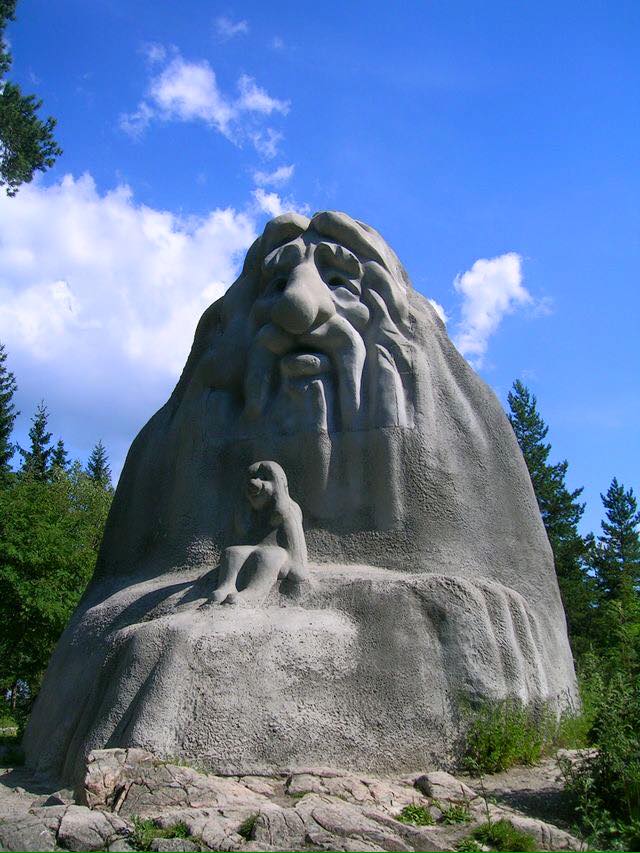
As legendary creatures, trolls have a long history of being depicted in folk art and, along with the Viking, have become a prominent tourist symbol in Norway.
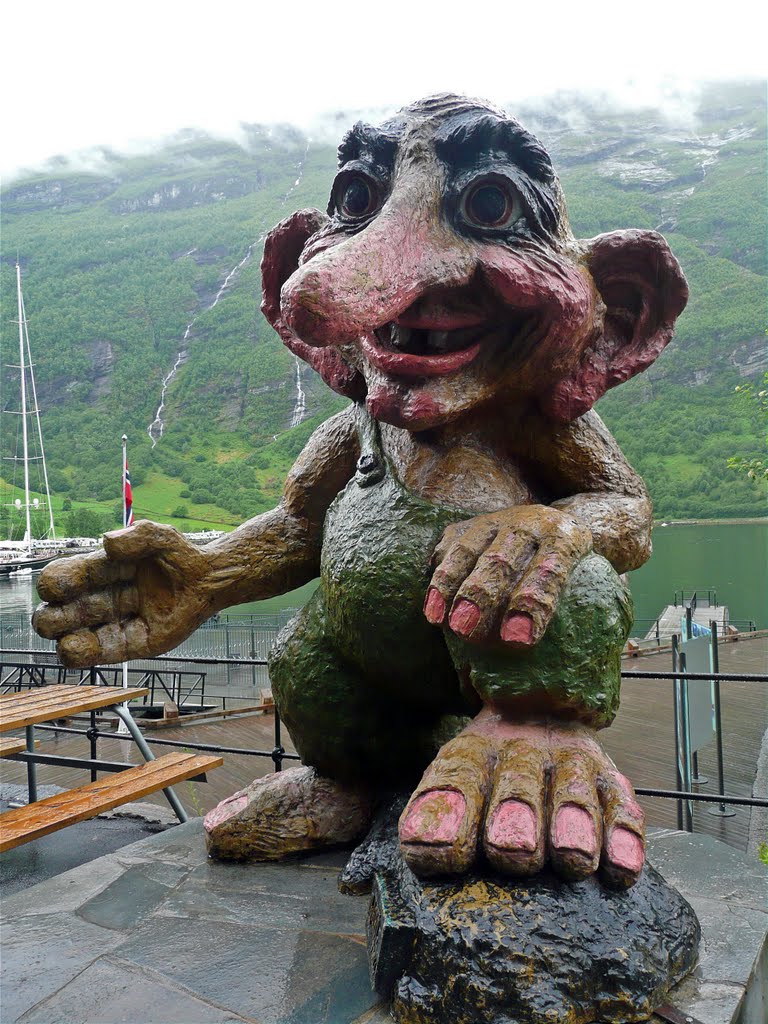
During my visit to Norway, I had seen many troll souvenirs made from clay with fluffy hair for sale in the tourist gift shops. However, I wanted to acquire an authentic hand-carved piece of Scandinavian folklore, and was lucky to later stumble across some very peculiar looking wooden troll carvings made by Norwegian woodcarver, Anton Sveen, which reminded me of the characters in a children’s TV show called The Wombles (most likely due to the long nose).
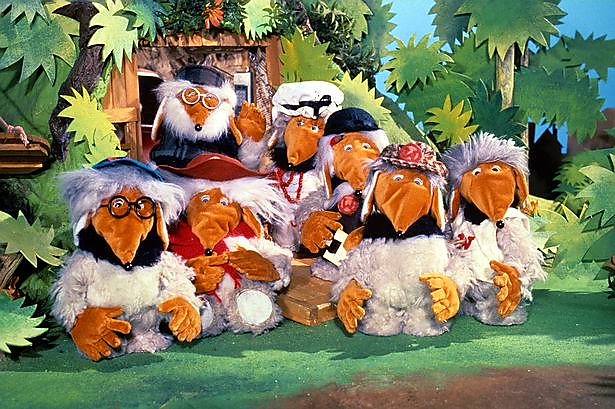
Anton’s trolls immediately peaked my interest, as I am an avid collector of the strange and unusual. After some further research, I was not able to find a single site or article dedicated to the artist and his woodcarvings. It was at this point that I decided to write my own article from the bits and pieces of information scattered throughout the internet to honour this great woodcarver. Below is my attempt at uncovering the life and story of the Norwegian woodcarver, Anton Sveen, and his unique hand-carved trolls.
Anton Sveen lived most of his life in the small hamlet of Lora, in the mountain district of Lesja – a small village in Oppland county, Norway, which is part of the traditional region of Gudbrandsdal.
Anton’s nephew, Magne Sveen, had the following to say about the Sveen farm and family, “I own the childhood farm where my uncle Anton was born. Uncle Anton and Aunt Jenny built a house on the farm which is still there and is now owned by a young member of Anton’s family. The farm is located in Lesja, in the very northern part of Gudbrandsdalen.”
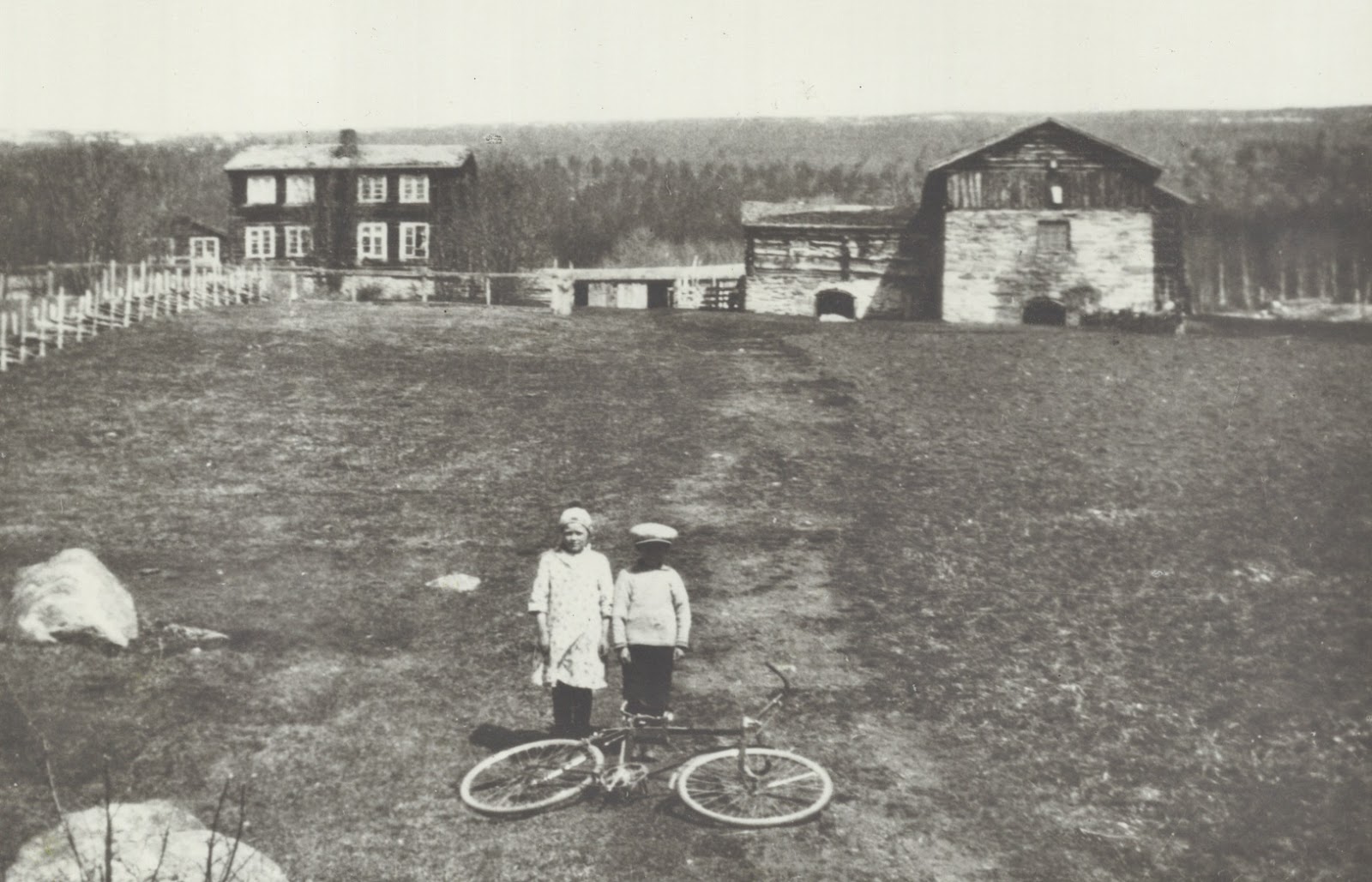

“The farm was bought by my grandfather, Ole Leirmo, in the 1890s. He changed his surname to Sveen, the name of the farm. Ole was extremely talented and completed his studies at the Academy of Arts in Oslo and continued for another two years at the prestigious Academy of Arts in Copenhagen. He moved back to Lesja, married Marie and they had 14 children, of which 11 grew up to adulthood. Ole devoted his time to carving jewellery boxes and other fine arts that were sold in the valley as gifts for baptism, confirmation, wedding presents, etc. He also carved his own style of decorations into chairs, tables, mirrors, etc. He must have been a great motivator, as he inspired many of his children to go the art way.”
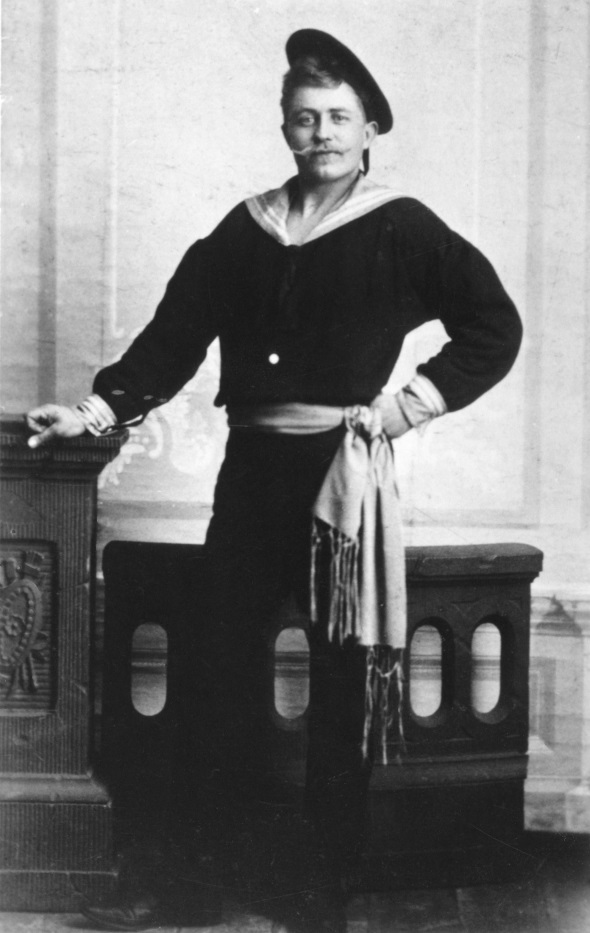

Anton began making wooden carvings in the 1930s, but he only started making the troll characters we know and love today in the 1940s. ”I made all the furniture in my house and attended school at Hjerleidske, but gave up carpentry after 2 years. For 30 years now I have had a solid relationship with a wholesaler selling my carvings. Before I also made root bowls, nutcrackers and animal figures, but these items take too long and are not as well paid as trolls.” (Anton Sveen, 20 September 1969, Gudbransdalen Newspaper).
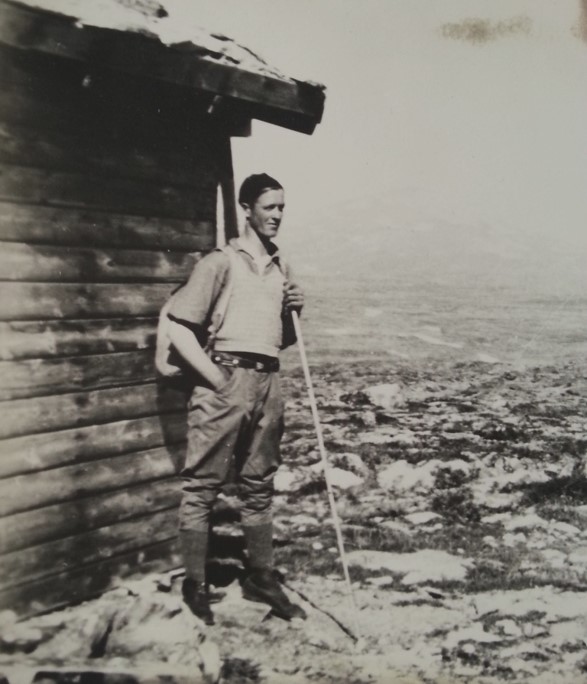
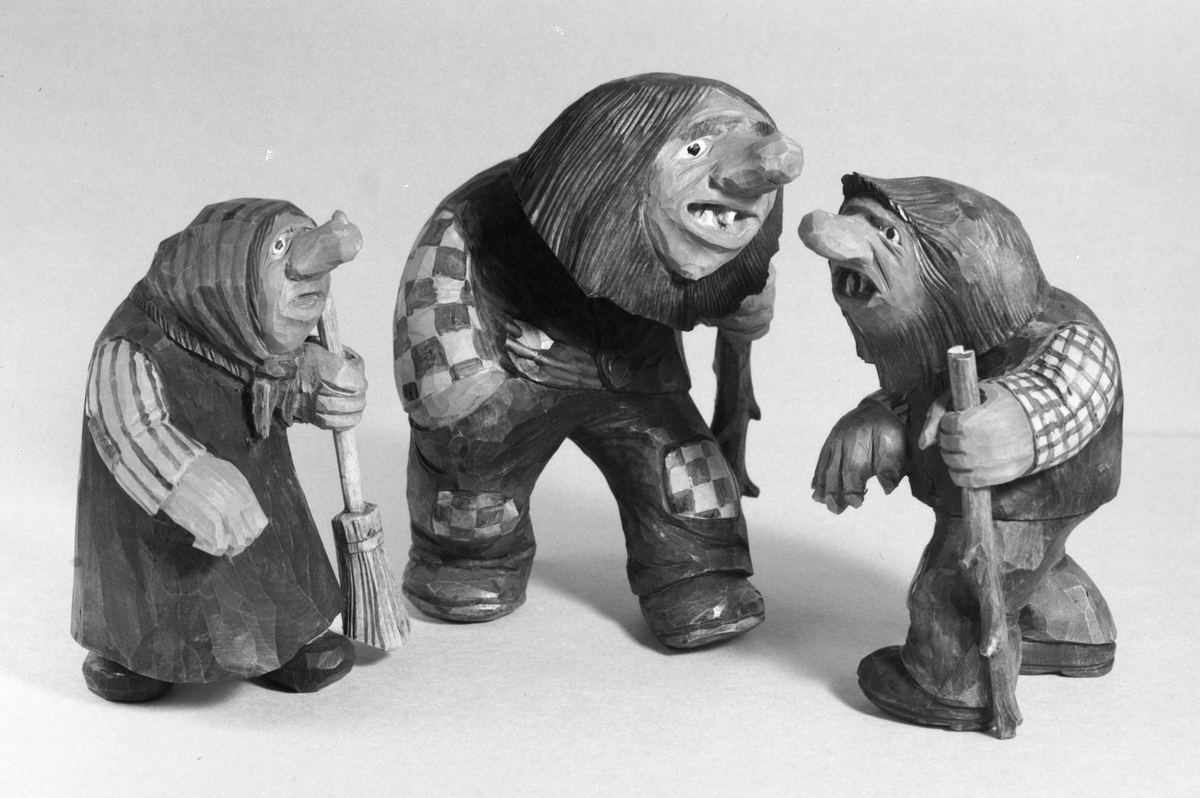
Anton turned his attention to trolls early on and built a career that eventually involved his entire family in the production process. His troll carvings became extremely popular, and their value rose as the worldwide interest in anything “troll” grew in the late 20th century.
Each troll is carved from one piece of hard mountain birch wood. The birch tree is only found in the Northern Hemisphere and is commonly found in Norway. Even though it is a light wood, birch is strong and durable. It is harder than other hardwoods, making it difficult to work with when using hand tools, such as carving and chipping. ”I collect many large blocks of birch wood and store them for up to three years to make sure they are dry. If they are not, the wood will crack after being cut.” (Anton Sveen, 20 September 1969, Gudbransdalen Newspaper).

Anton began the troll creating process by chopping the birch wood block with an axe to create a rough design of the troll. This was done in the cellar of his house. The wooden outlines were then taken up to the kitchen where he had a separate table to start the process of carving; first using big woodcarver irons and then smaller irons and knives to define the details of his troll characters.
Anton provides some insight into the tools he used and his thoughts on the future of the woodcarving industry ”To create my trolls I use an axe, chisels, and knives. But soon the machines will take over. They can make the carvings quicker and cheaper, something that an artist cannot do. If times evolve similar to recent years, I do not think that wood carving has a future. I must spend 12-15 hours a day to make real profits with my trolls.” (Anton Sveen, 20 September 1969, Gudbransdalen Newspaper).

Many of the trolls are similar in design, however, each troll has its own unique features and characteristics. When it comes to collecting Norwegian hand-carved trolls, it seems the uglier they are, the more people want them.
Anton’s male trolls are most often designed in a walking motion with a hunched back, wearing an open waistcoat, long trousers, pipe in their mouth, walking stick in one hand and the other hand is most commonly found in the troll’s pocket. However, I have come across some unique trolls with the other hand holding a key, axe, or a sack. The trolls often have checkered patches where they have torn their pants by the knees/ bum, or on their shirts by the elbows. There were also some unique trolls made with suspenders or in a sitting position on a rock.
The way Anton carved the troll’s eyes and eyebrows added life to the character, it made them look curious like they were peeking around a corner spying on someone or perhaps shocked because they had encountered a human.

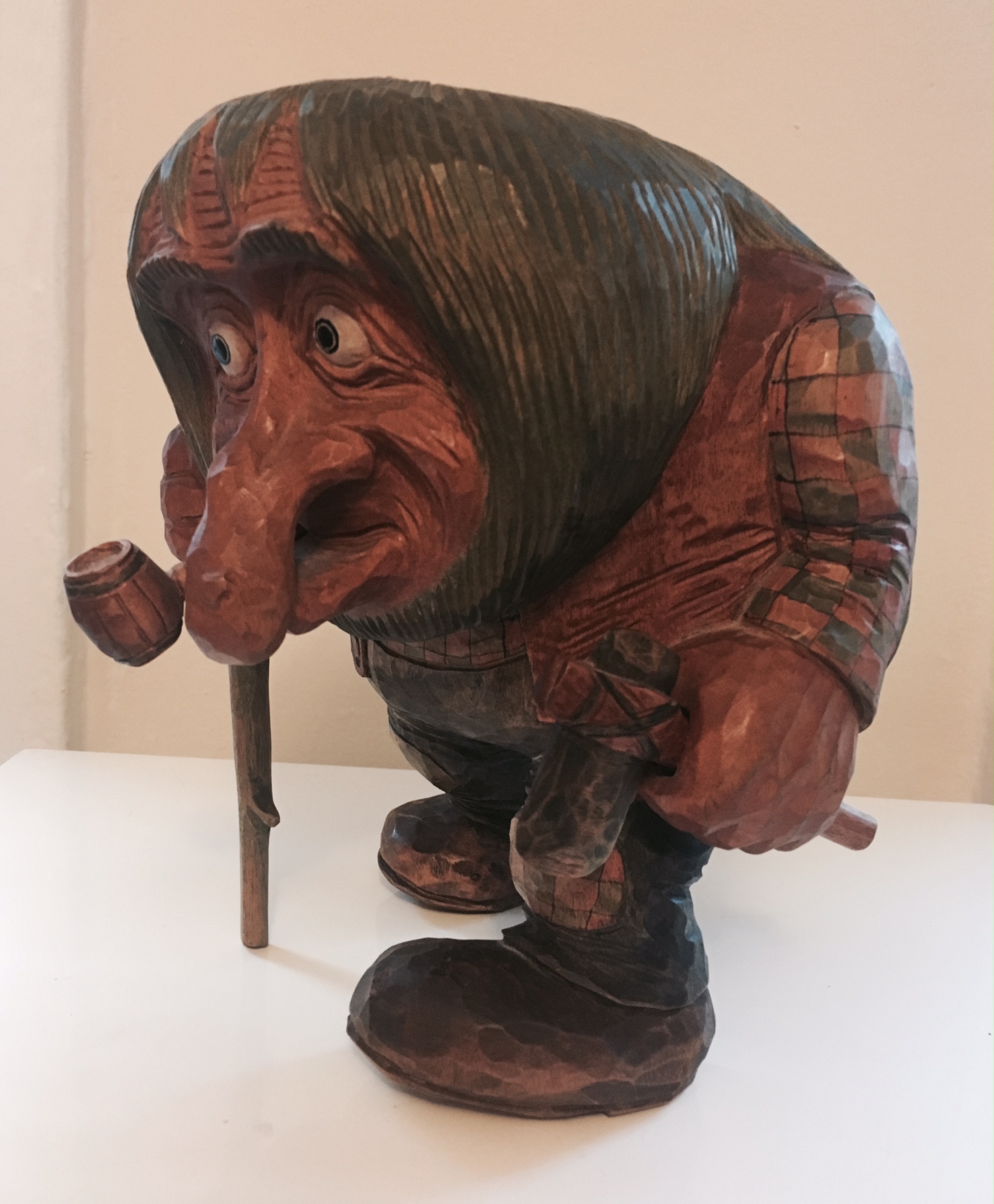


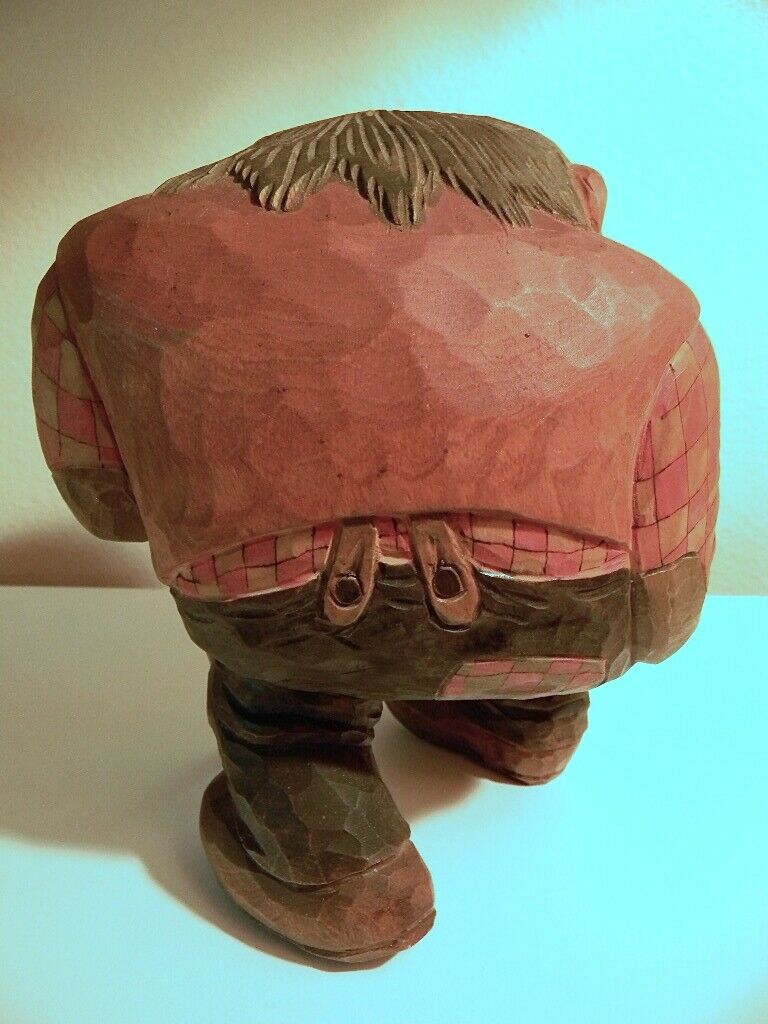
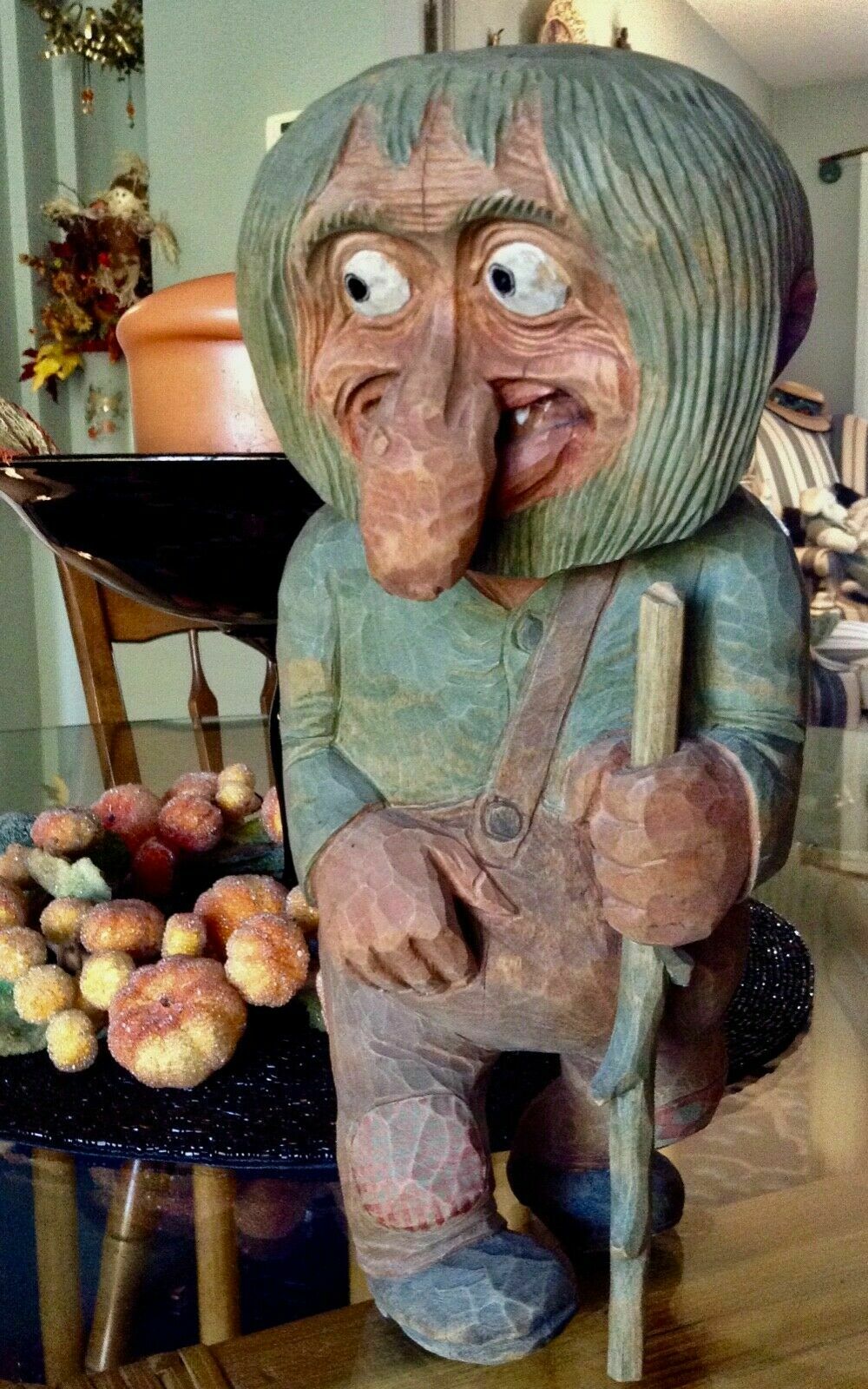
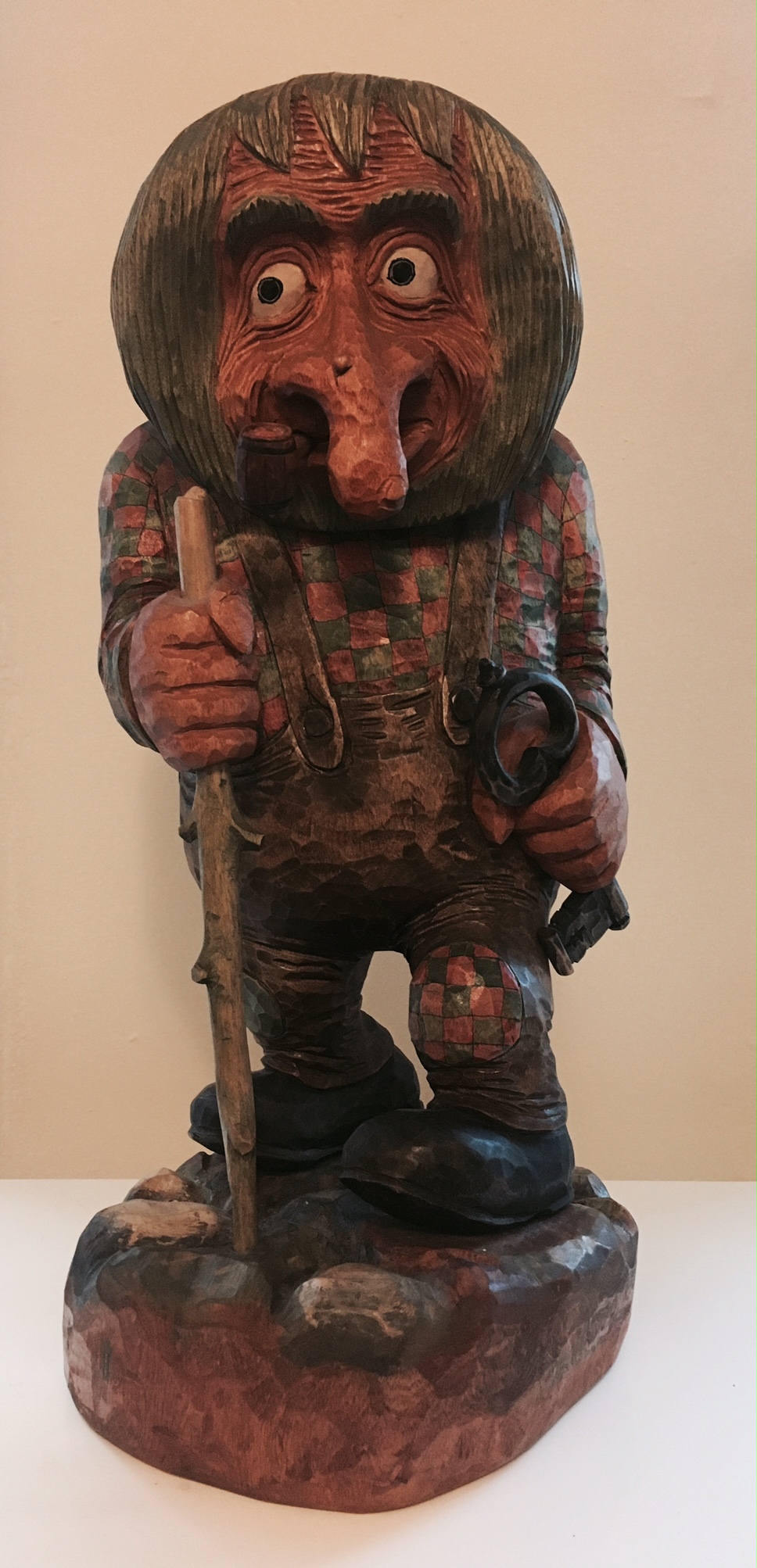

Anton’s female trolls are most often designed in a straight standing pose wearing a headscarf and holding a broomstick in one hand and the other hand hanging freely at the side, or on some unique carvings, holding a basket. Like the male trolls, they also have checkered patches where they have torn their dress in the front and back.
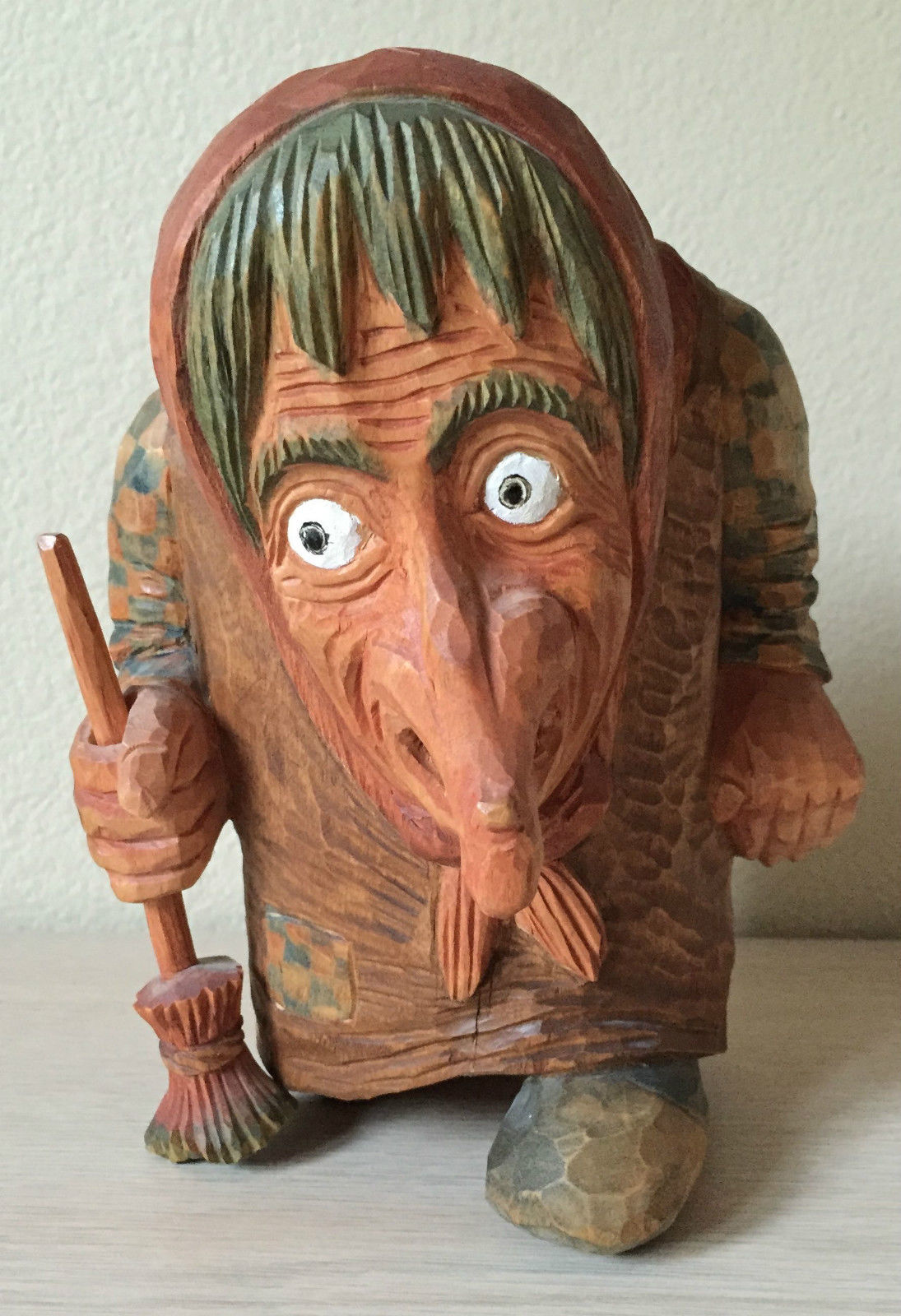

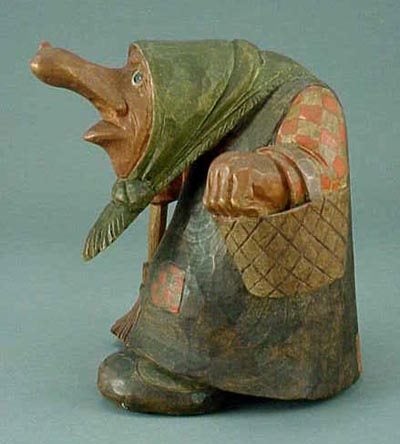

It is said that Anton carved the male and female troll couple from a single block of birch wood, making them a perfect match.

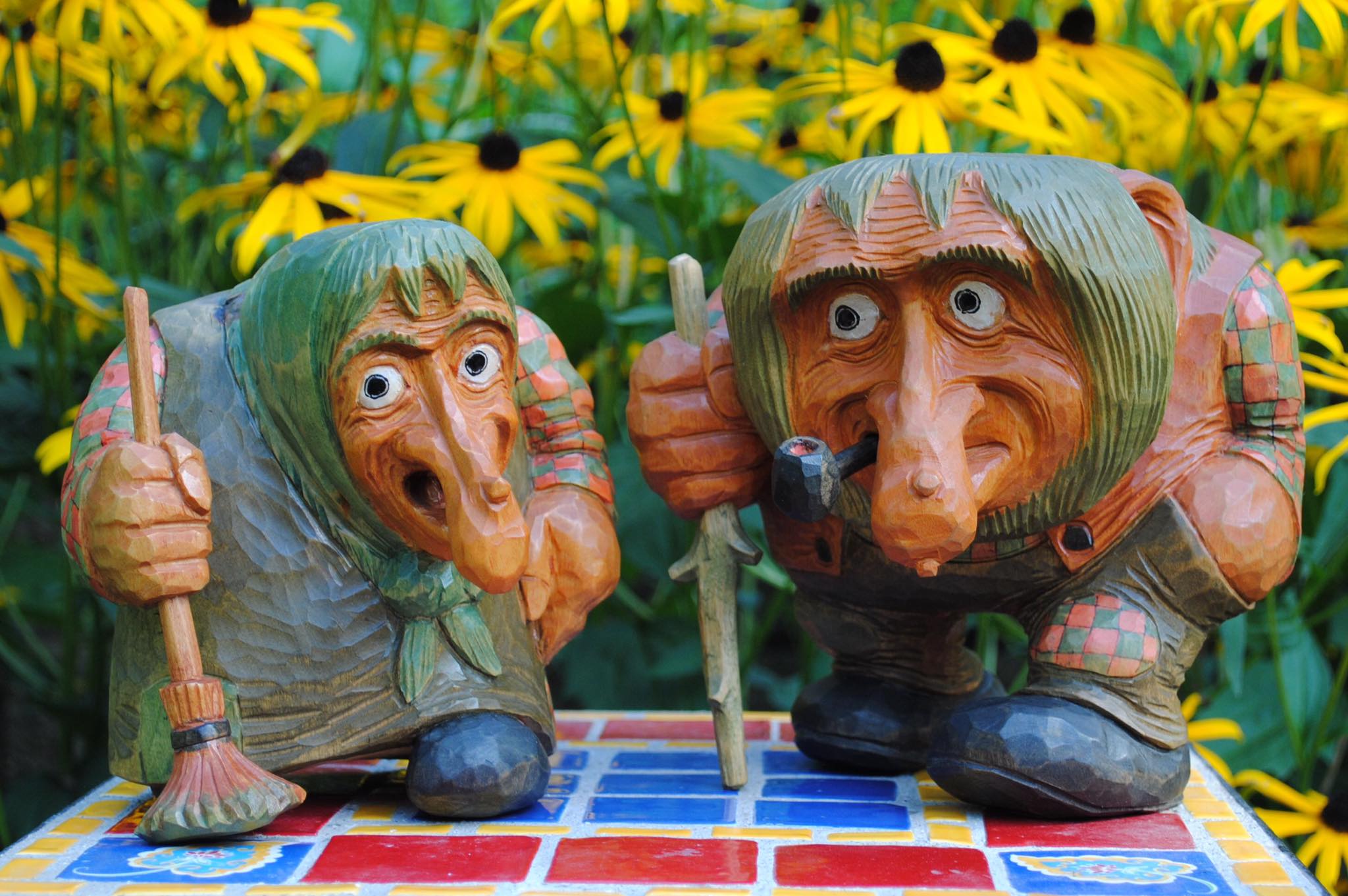
There are different facial expressions, as well as types of stances they were carved in and the attention to detail in the carving is simply amazing. The care given to the way the wood was finished is obviously with lots of love and plenty of skill.
”I have worked on my troll design for over 30 years now, and I believe that the design has become considerably better and more perfect than when I started. Cutting trolls does become monotonous, so from year to year I try to make small changes to the trolls.” (Anton Sveen, 20 September 1969, Gudbransdalen Newspaper).

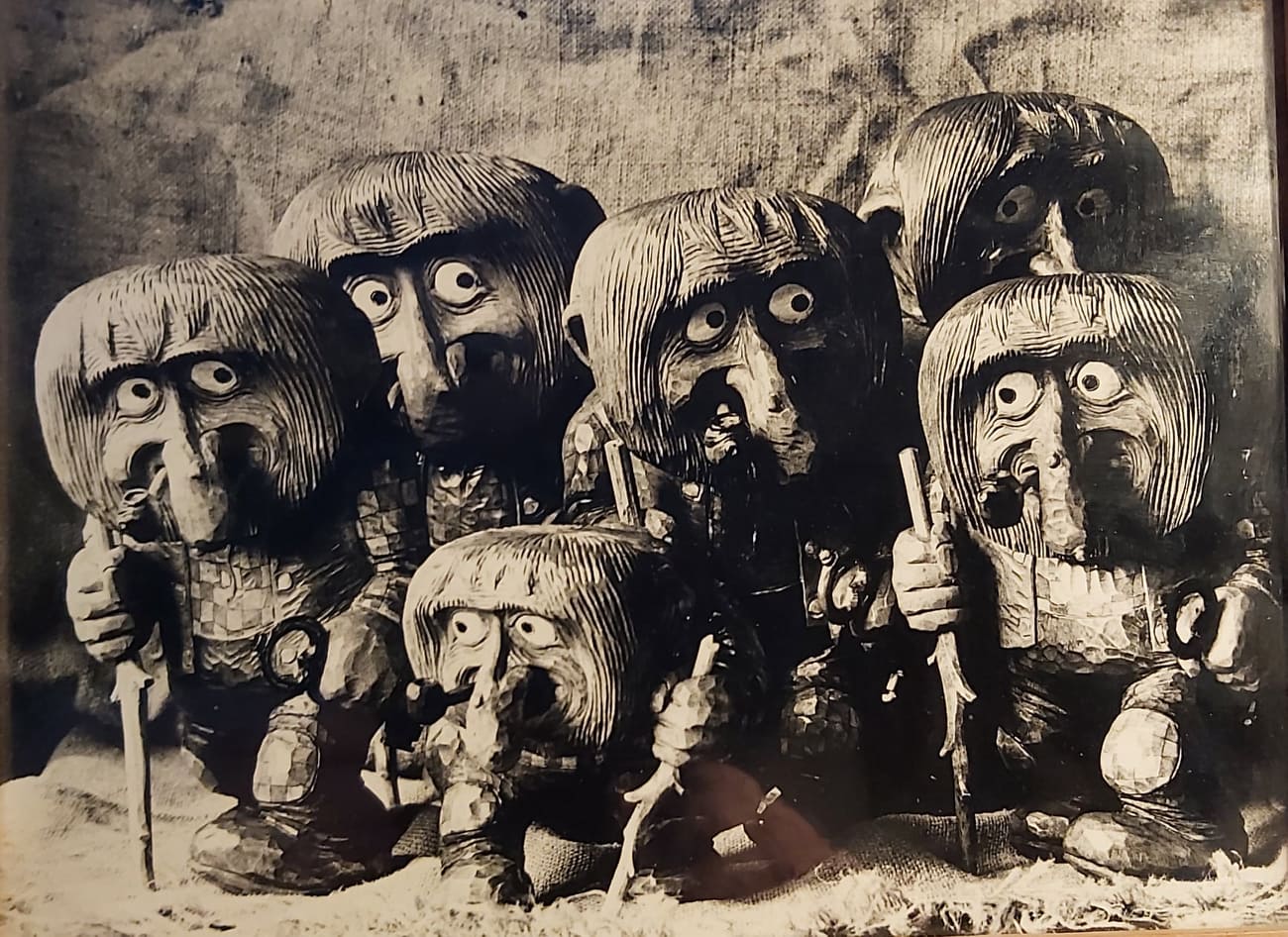
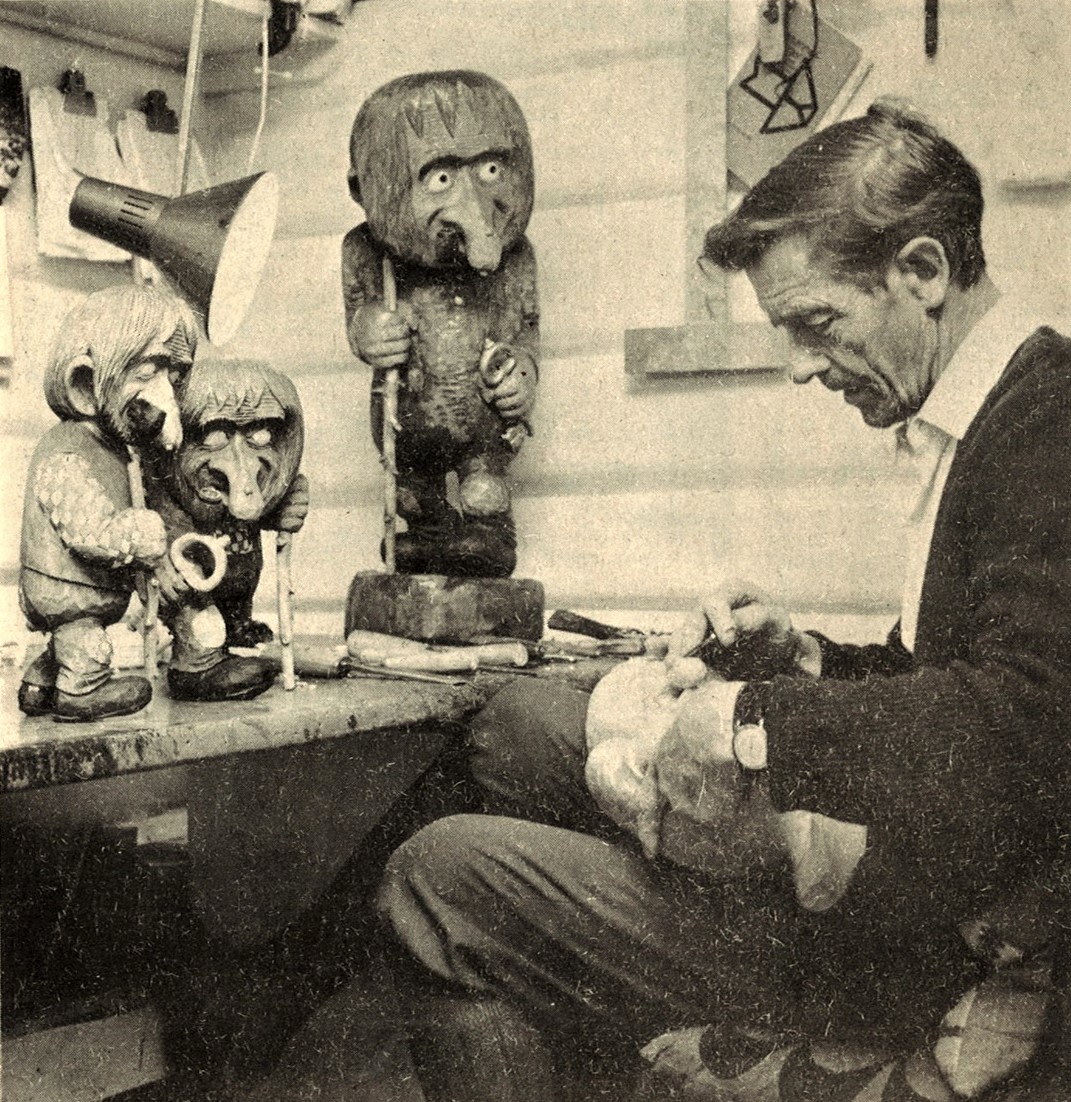
When the carving process was finished – Anton’s wife, Jenny Jensløkken (1922-2004), had the job of painting the trolls. According to their son, Oskar Sveen, ”In the beginning, mother had enough work to do around the home with looking after five children. She took over the troll painting as we grew older. Dad still painted the red squares and the eyes so they would look in the direction he wanted.”
Oskar describes the painting process, ”My mother used oil paint that came in tubes, which she thinned with vegetable turpentine, boiled linseed oil (50/50) and a little desiccant (Sikativ oil). The checkered red squares were time consuming as she painted them one by one. She then used alcohol stain which dried quickly. The blue was an oil paint which she painted all over and wiped away with a cloth. The blue did not stain the alcohol stain. She used marten hair brushes of various sizes. Mother was very accurate. I know this, because I painted for my father when I was very young.”
Oskar also gives some advice for anyone wanting to refurbish the colour and shine of a Sveen troll, ”Older matte trolls can be refreshed with boiled linseed oil and vegetable turpentine, but wipe it away so they do not become too shiny.”
Magne Sveen had some further memories to share, “Uncle Anton was a very kind man with a great sense of humour. He was married to Jenny, who sat by his side for all their 40 years of production, painting the trolls. They were my godparents. Anton produced one set of trolls, with the same colours, fashion, and face in 4 sizes, small, medium, large and then the tall “gubber” male trolls of 50-60cm (or more) in height. Anton and Jenny sold thousands of trolls, and based on the earnings, brought up a family of five children.”
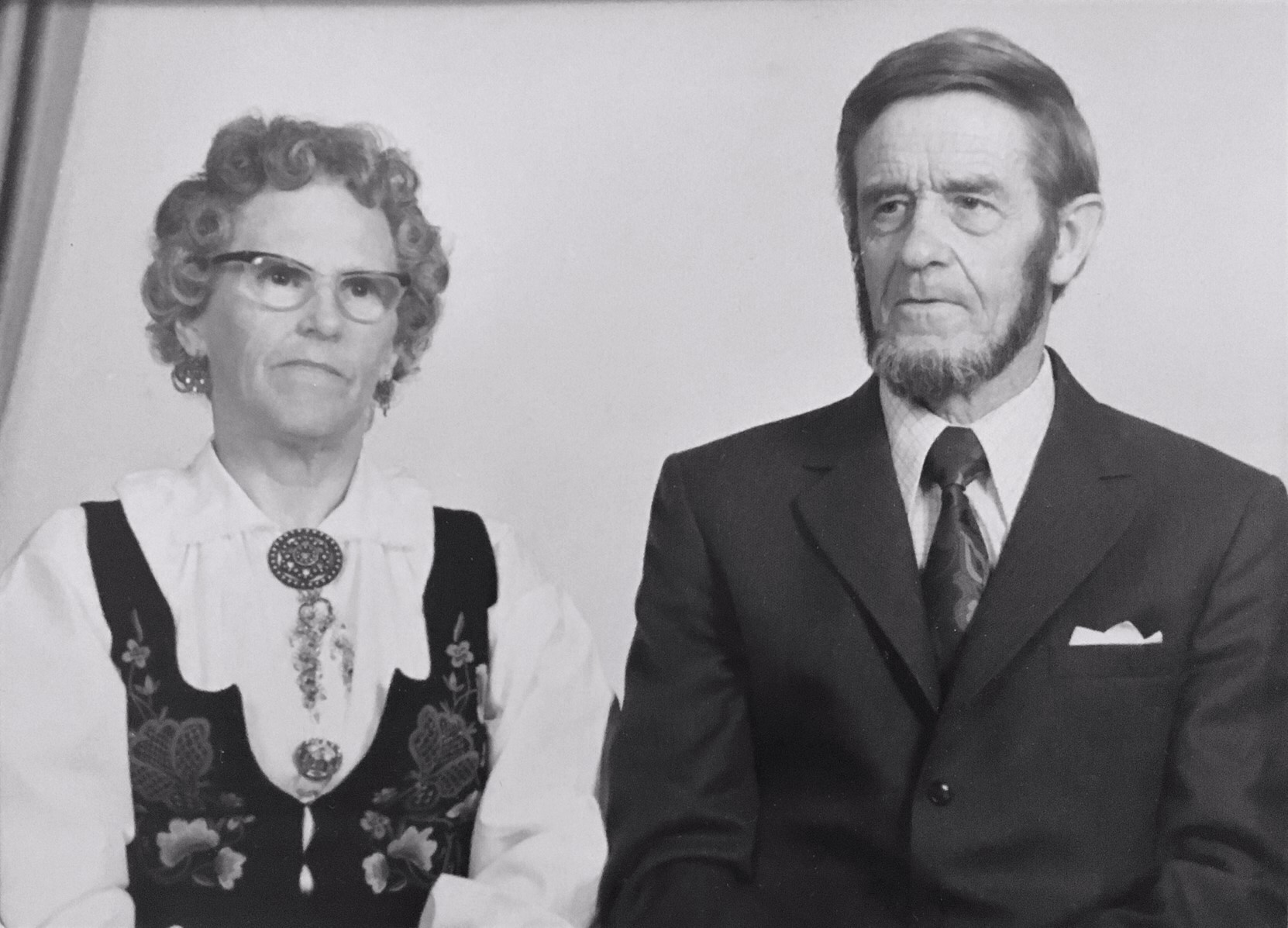



Anton also produced a small number of unpainted trolls. According to Sigrid Lyftingsmo, whose parents bought trolls directly from Anton Sveen in 1985, ”My parents told me that the trolls were unpainted because some Americans were afraid that they were made of plastic.”
Anton’s signature (ASv) can be found carved underneath the foot of his trolls. However, it seems that many of his earlier trolls were not signed. These trolls can still be authenticated by the characteristics/features, quality, type of wood, and unique carving style of the artist.
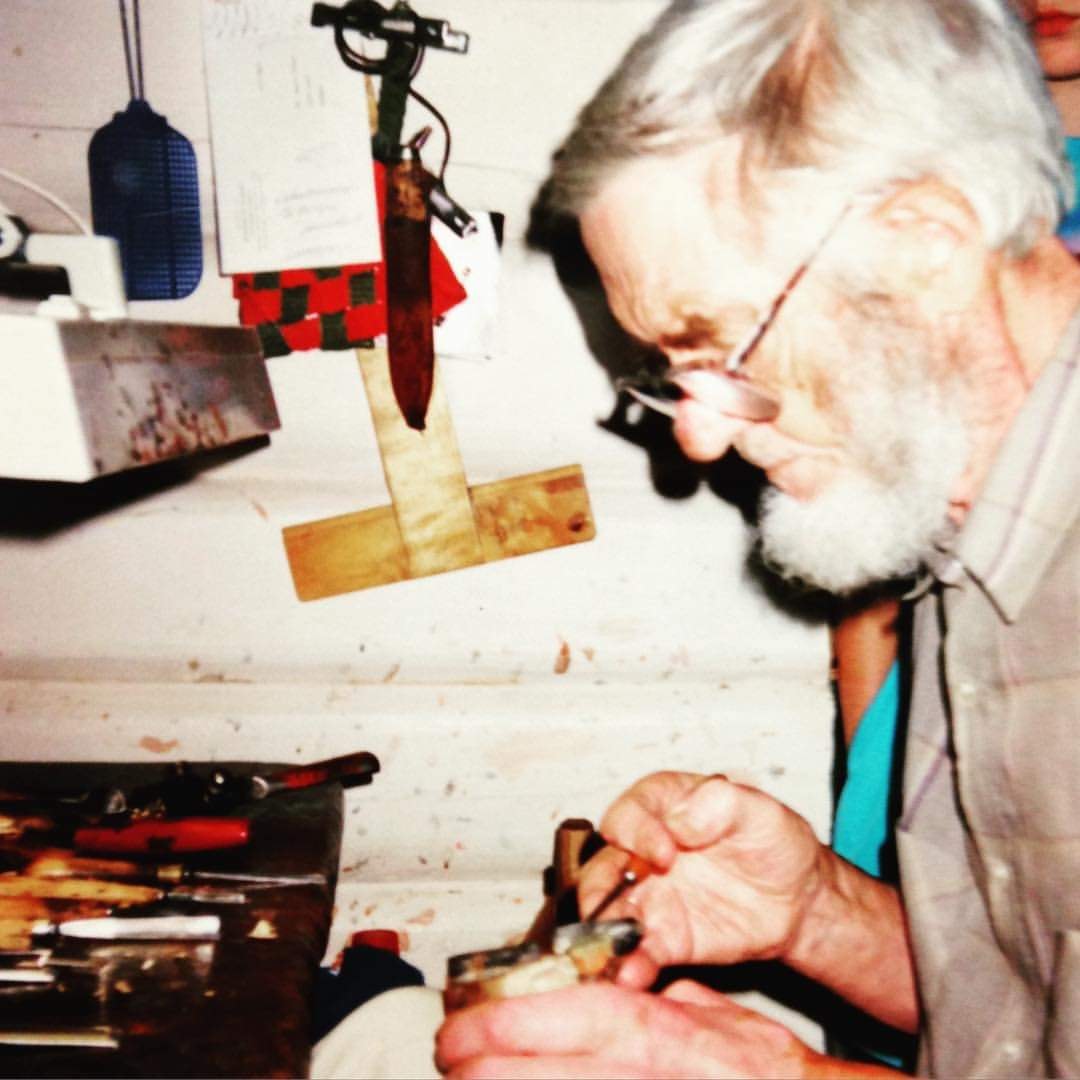

Through my research, I identified that Anton also marked his trolls with Roman numerals (I, II, III, IV, etc.), letters (A, B, C, D, E, F, etc.) and numbers (e.g. 24/50). Although it is uncertain as to what these markings indicate, my guess would be that they indicated either the decade in which the troll was made or the batch of trolls from which the troll was made with. Examples of these markings can be seen below:
I managed to make contact with another of Anton’s grandchildren, Jackson Sveen, who had the following interesting information and family stories to share; “Arnfinn Sveen was my father and Jenny and Anton’s youngest child. Unfortunately, my family stories are limited. My grandparents never spoke any English and my Norwegian was and is still pretty limited. Still, I loved them very much! They had very fun, quiet, and calm personalities. It seemed that Jenny was much more of a talker than Anton was. My favourite story about my grandfather was from 1982-3ish when my grandparents came to the United States (US) to visit. When he was going through security he was wearing a belt with all his carving knives attached. Of course, they told him he wouldn’t be able to bring them and apparently, he demanded that they travel with him. He said that there was no way that he was leaving without them. Sure enough, Anton and the knives made it on the flight. These tools were more to him than wood and metal. They were his livelihood. They were a part of him. Of course today you’d be put in the airport jail for trying to do that.”
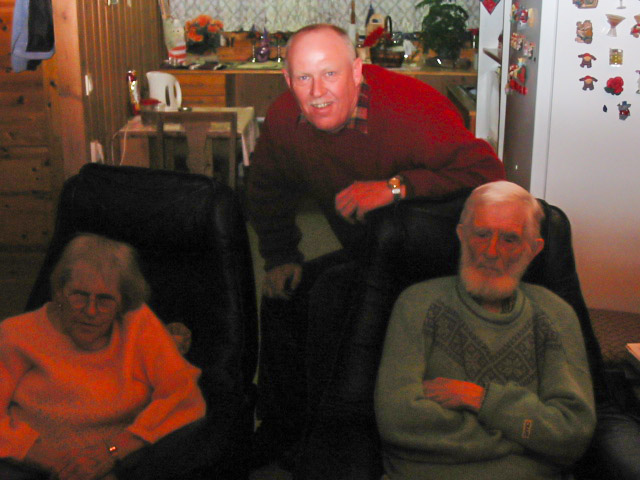
I was also told quite an interesting story by a collector (who wished to remain anonymous) regarding their parents’ experience of visiting Anton Sveen in Norway in the 1980s:
“My parents were avid collectors and travellers. They took an extensive 3-month vacation through many Scandinavian countries and Norway was one of them (my parents and myself live in the US). My parents had looked at a variety of trolls to purchase on their journey, but just couldn’t find one that satisfied them until they walked into a random hotel in Geiranger, Norway and saw two of Anton Sveen’s trolls (one male, one female) on a shelf in the lobby and just loved them… so much so that they bought them from the hotel.
A few days later, they were on the Trollstigen Mountain Road where trolls are thought to live in the surrounding hills and valleys and they stopped at a gift shop there, where they saw more Sveen trolls to their surprise. They bought a couple of them there and the owner of the shop mentioned that if they are in Lora, Anton Sveen doesn’t mind visitors. When they arrived in Lora, the people in the town gave my parents directions to Mr. Sveen’s house. When they got there, they walked right up to his house and knocked on the door and his wife answered and invited my parents in and there he was, sitting at his workbench working on trolls.
My parents commissioned Mr. Sveen to produce about 40 unique trolls, and he shipped all of them to my parents in the US. About half of the commissioned trolls were given away as gifts, another portion was sold on ebay, and my mother still has a few on display at her home and the rest are in storage. My mother remembers that Mr. Sveen had a humongous pile of birch wood blocks in his backyard for future trolls. He also had various trolls around his house, which were part of his personal collection and were not for sale.”
The photos below were taken during the visit to Anton Sveen’s home in Lora, Norway, including a picture of his house, Mr. Sveen at his workbench, and the interior of his house showing some of his personal trolls (a large troll holding a key and a unique troll sitting on a rock). There are many interesting small details to look at in each picture, including some trolls in various stages of creation.




Dutch troll collector, Hanny van Langevelde, also got in touch with some amazing pictures of her Sveen troll collection and of the time she visited and purchased trolls directly from Anton and Jenny Sveen in October 1983. Hanny first visited the Sveen family on her 18th birthday (1981) while on holiday in Norway with her Aunt and Uncle. ”The first trolls we bought were from souvenir shops in 1980, my uncle speaks Norwegian and he asked where Anton lived. In 1981 we visited Anton and Jenny and bought the other trolls directly from him, including the 5 unpainted trolls. We visited a second time in 1983 and took these pictures in his house, and at the table where he made the trolls. During that visit we bought nine trolls; seven painted and two unpainted.”


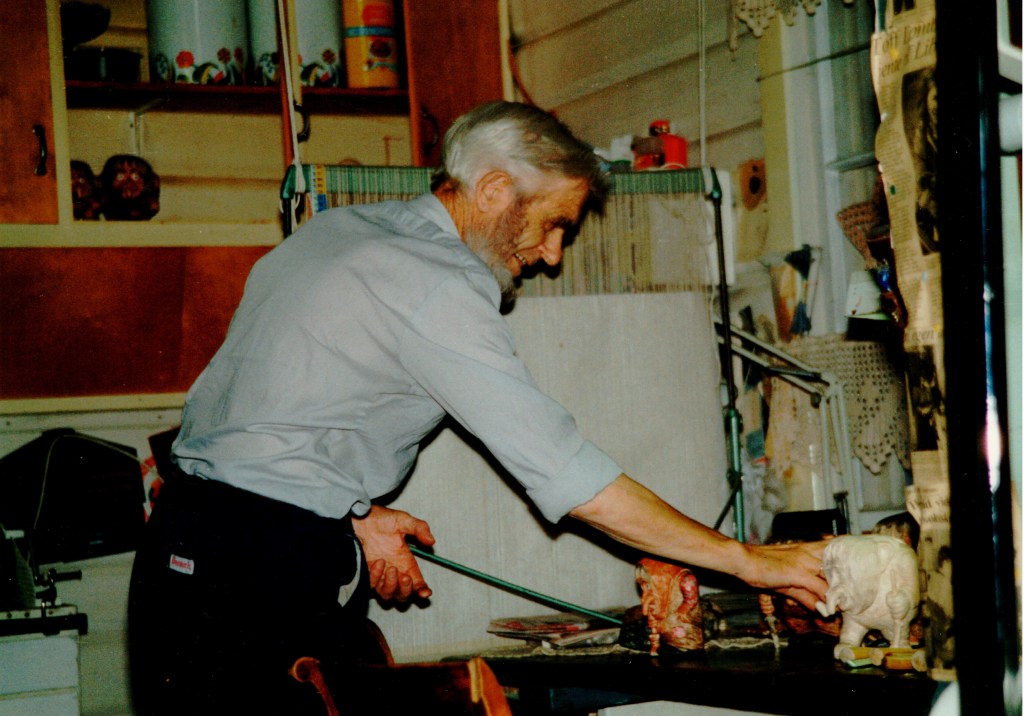

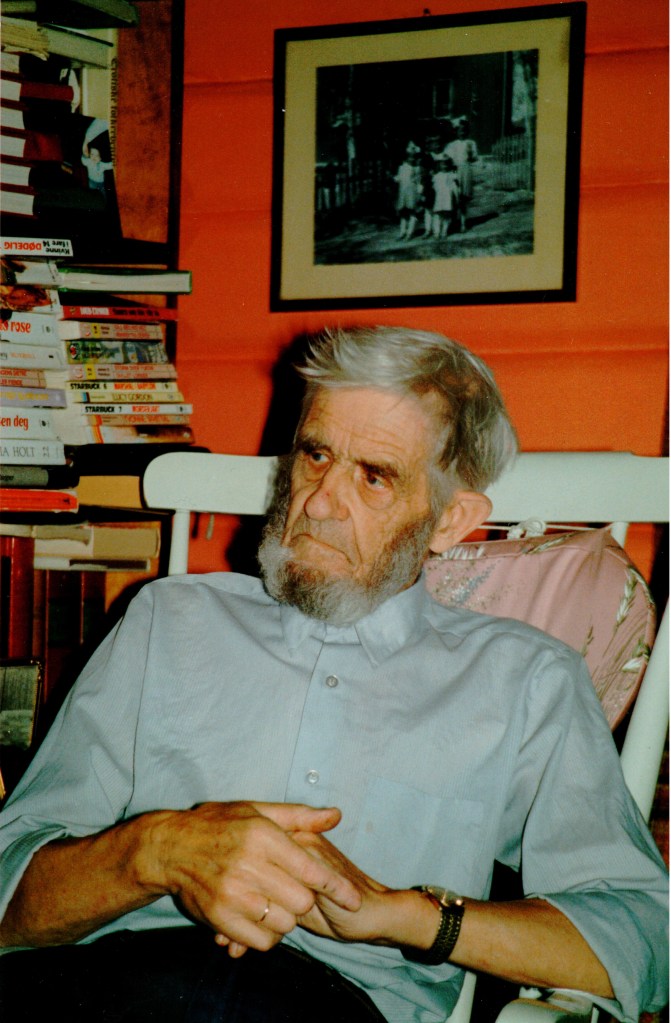
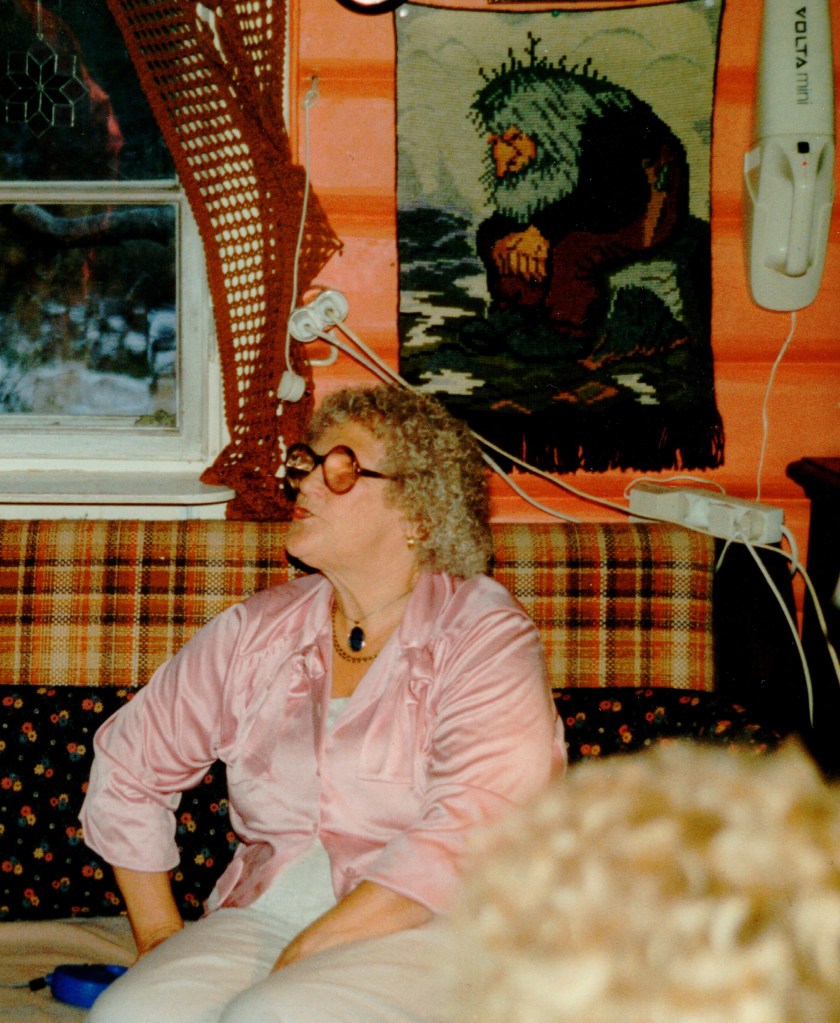



Hanny’s Aunt has more than 100 Sveen trolls. ‘’My Aunt and Uncle visited Anton and Jenny many times. My Aunt had a knitting work of a sitting troll and I think she asked Anton to make one out of wood. I know that they would always send cards by post to Anton and Jenny. I now have many trolls from Anton in my personal collection and only one troll from Otto.’’
Below are the pictures of Hanny’s personal Sveen troll collection:
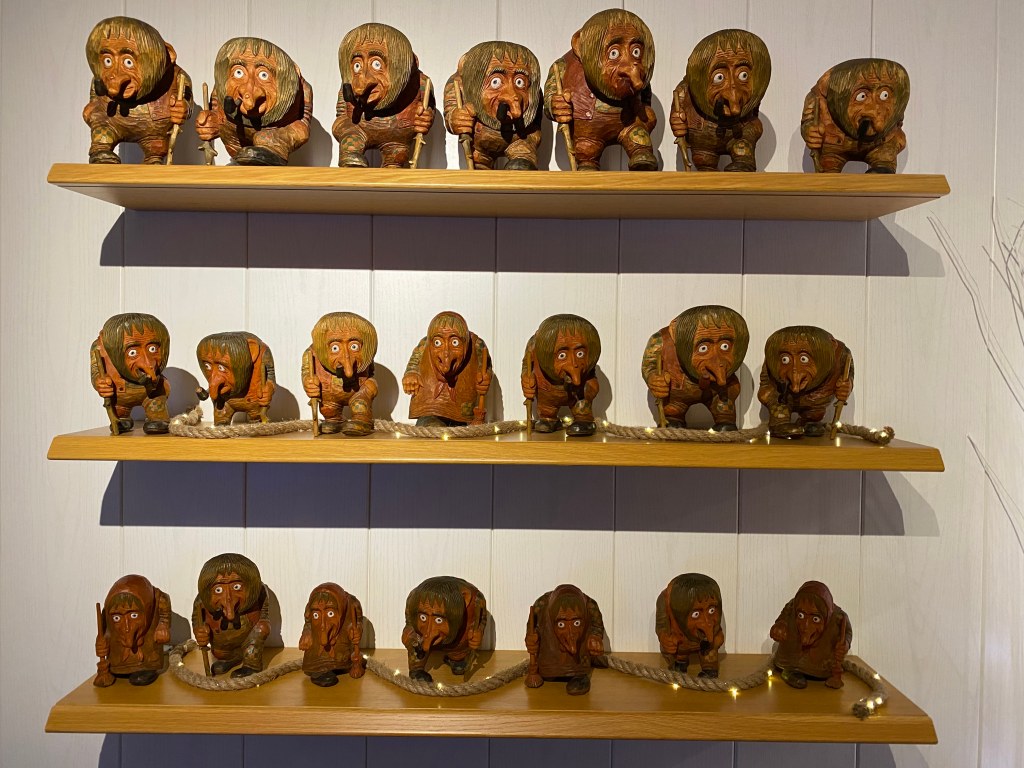

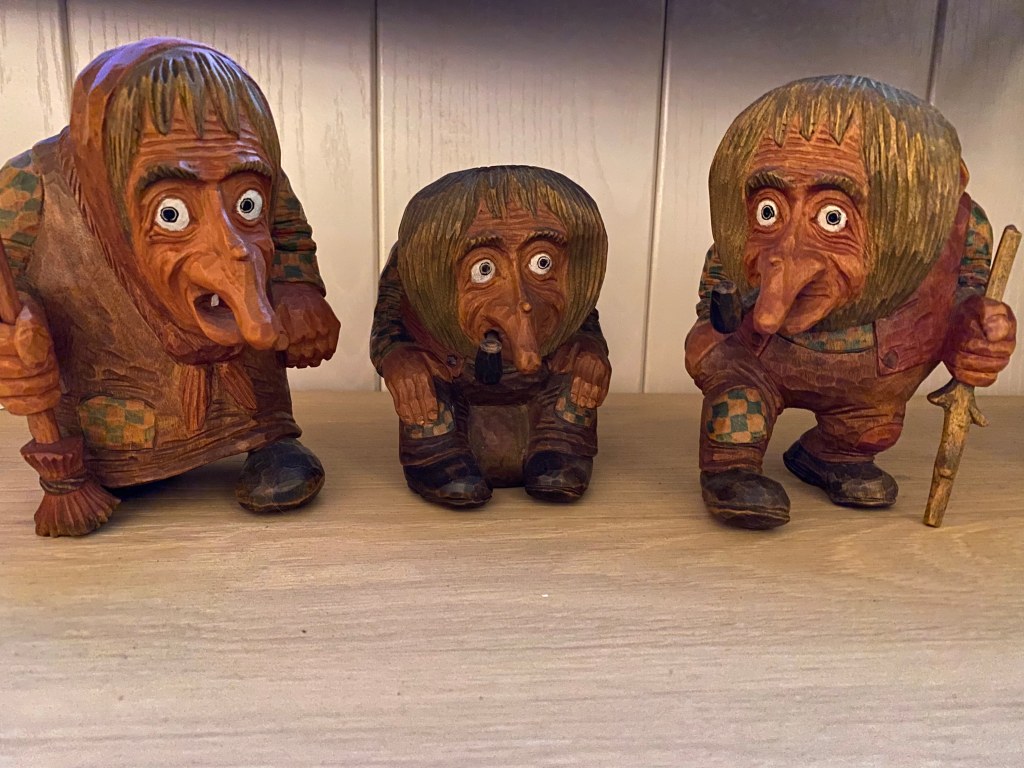


Anton’s older brother, Otto Sveen (1910-1997), was also an accomplished carver.
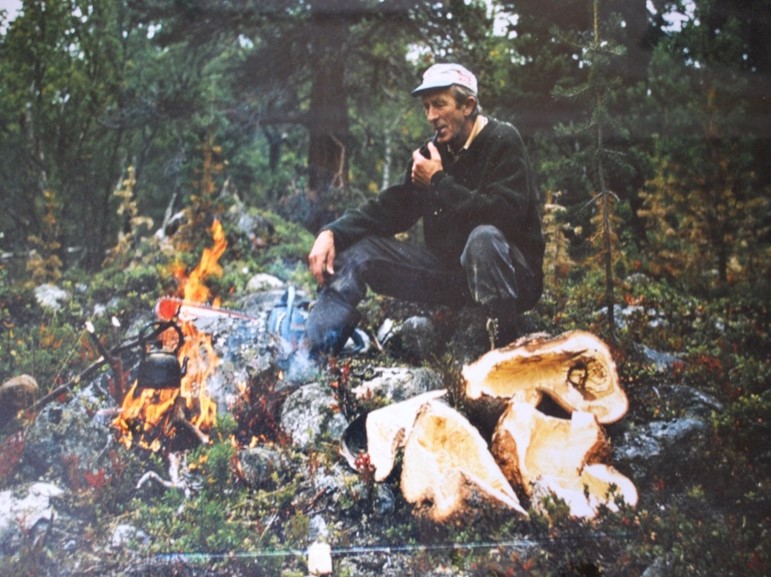
Otto was famous for creating carvings, sculptures and decorating churches. He spent several years decorating Lesjaverk church in Gudbrandsdalen. He made the altarpiece, pulpit, and baptismal font in the church.

Otto also produced carved trolls, quite unique, but simpler than the trolls Anton made. Otto’s trolls were usually shorter, fatter, had a smaller round nose, and were happier looking with a smile. Whereas Anton’s were taller, had a long drooping nose, and harsher looking face. Otto also signed his trolls beneath the foot with “OSv”, but like Anton’s trolls – this is something he seemed to do later on, thus not all of his trolls are signed.
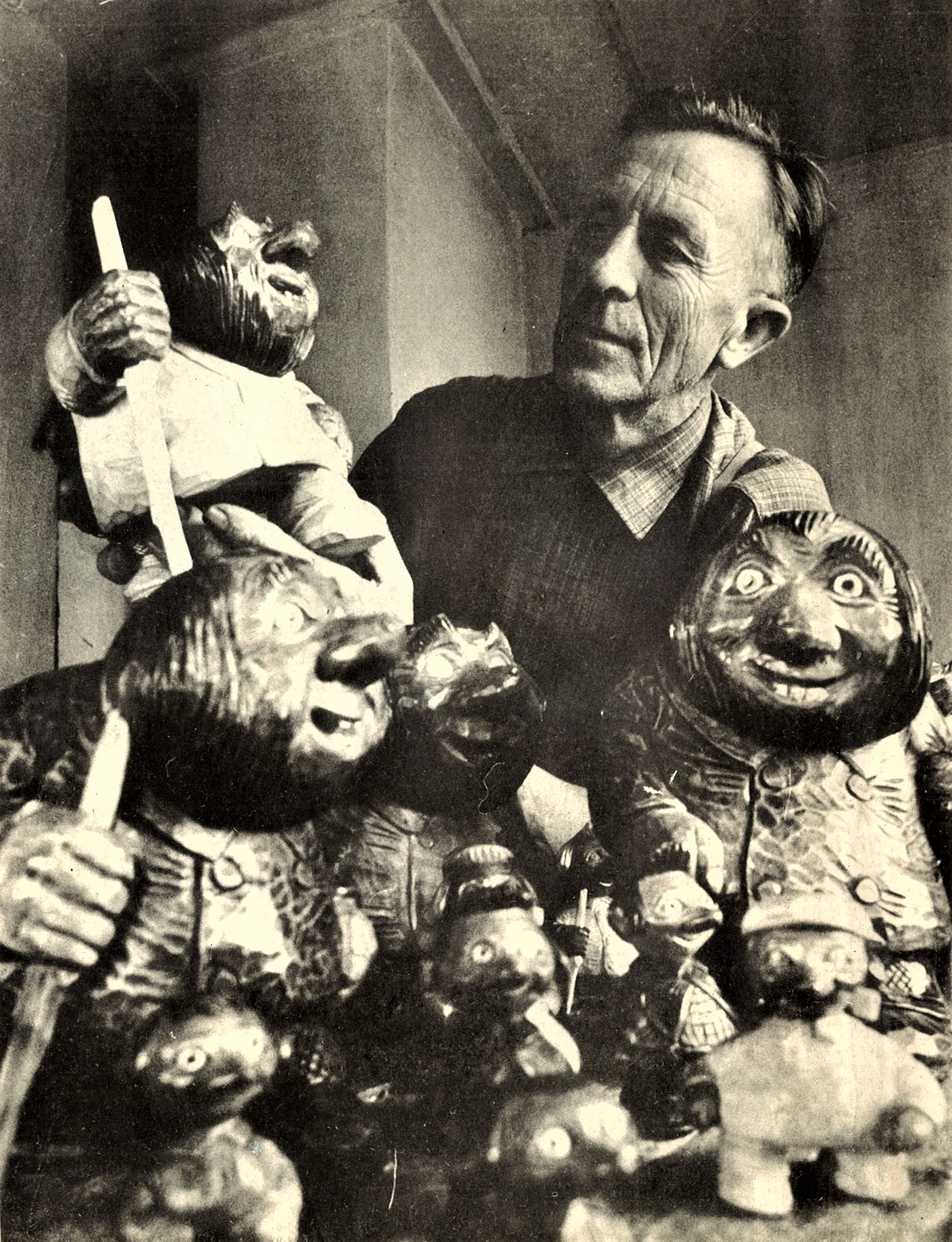
Below are some pictures of the trolls created by Otto Sveen:


Anton’s trolls were sold by speciality retailers in Norway, on Norwegian cruise ships and at selected shops around the world. Today, these collectable wooden trolls can be evaluated using the criteria below:
- The size of the troll – Anton charged more for his larger trolls. He did not make many due to the amount of time and effort taken to make the troll.
- The rarity/ uniqueness of the troll – Sitting on a rock, holding an axe, key, basket, or sack, wearing suspenders/ dungarees, etc. Surprisingly, age is not a factor which seems to affect the value of Sveen trolls, as the troll design was improved over the years and many of the very early trolls I’ve seen have been very faded and not in good overall condition.
- Missing pieces – It is common to find Anton Sveen trolls with missing pipes. Sometimes the walking sticks can be broken too since they are detachable and weak points. This will affect the value of the troll.
- The condition of the troll (the points below can affect the value of a troll):
- Broken pieces – Wooden carvings often break and get repaired. For Sveen trolls, the hand holding the walking stick often breaks off as it is a weak point in the carving – so be on the lookout for a crack going full-circle around the wrist area before you purchase a Sveen troll. This is usually easily noticeable and will affect the value of the troll.
- Damages to the wood – if the troll has any cracks, chips, or scratches to the wood. Things such as cracks/chips/scratches are very typical for hardwood carvings, but the placing and size of the crack/chip/scratch can impact the value differently (e.g. if it is on the troll’s back, then this will not have a big impact on the value, as it would not detract from the troll’s sheer, um… beauty! However, if it is on the troll’s face or easily noticeable when displaying the troll, this can impact the value significantly. The same goes for the size; the larger the crack/chip/scratch, the more impact it will have on the value of the troll as there is a higher risk that the wood will split and break).
- Fading of the colour detail – over the years when the trolls are handled or cleaned, the paint often becomes faded and not so prominent. This can also happen if the troll is exposed to direct sunlight. You can do a comparison of your Sveen troll with the many pictures found in this article or on Google images.
- If the troll is signed (ASv) – Although many of Anton’s earlier trolls were not signed (but are clearly his unique design and master carving technique) – having his signature under the foot adds value to the authenticity of the troll.
Below is a slide show of photographs of Anton’s trolls found on the internet and a YouTube video:
On 22 August 1970, Anton Sveen and his wife, Jenny, appeared on the NRK TV show ”Vi stopper på Bjorli” where they described the different stages of the troll making process. The video can be seen below with subtitles in English.
In 1989 the three Sveen woodcarving brothers; Otto, Anton and Magnus received the cultural award in Lesja for ”Wood carving, combination of art and livelihood, work for conservation and development of wood carving” (Source: Overview of granting Cultural Award in Lesja from 1978). The newspaper clipping below covered this prestigious event. The caption reads ”Three artists in wood”. If you look closely you can see outlines of large and small trolls on the table with the white cloth.

According to Magne Sveen, “Anton’s son, Oskar Sveen (born 1942), is the only artist remaining from the family who brought the tradition of carving trolls through to our generation. He produced his own unique style of trolls and fine art. Oskar was a lecturer at the Oslo Academy of Architecture and specialised in wood carving and art furniture. He made the chairs for Pope John Paul II’s visit to Norway in June 1989 and for Norway’s Crown Prince when in Parliament. He also led projects in the USA decorating churches.”
Oskar carved the main entrance portal for the Stave Church called ”Chapel in the Hills” located in Rapid City, South Dakota, USA. The church is a faithful replica of the famous Borgund Stavkirke in Laerdal, Norway that was built around 1150 and is considered the most completely preserved stave church still standing in Norway.
When it comes to trolls, this was just a hobby and not a livelihood like it was for his father, according to Oskar, ”I carved a few hundred trolls at a young age.”

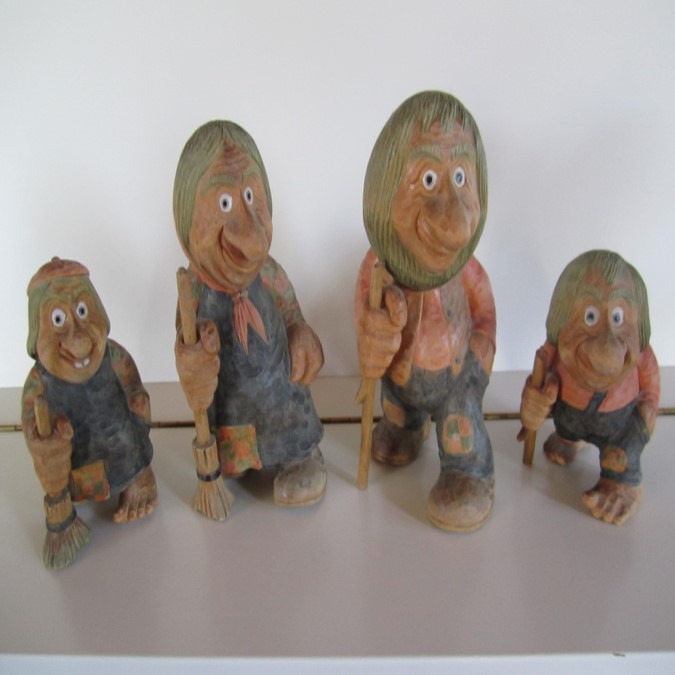
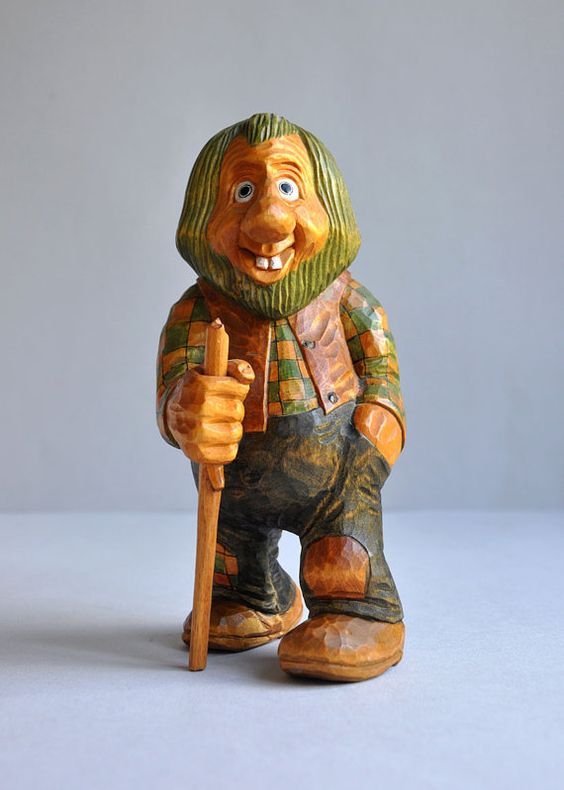
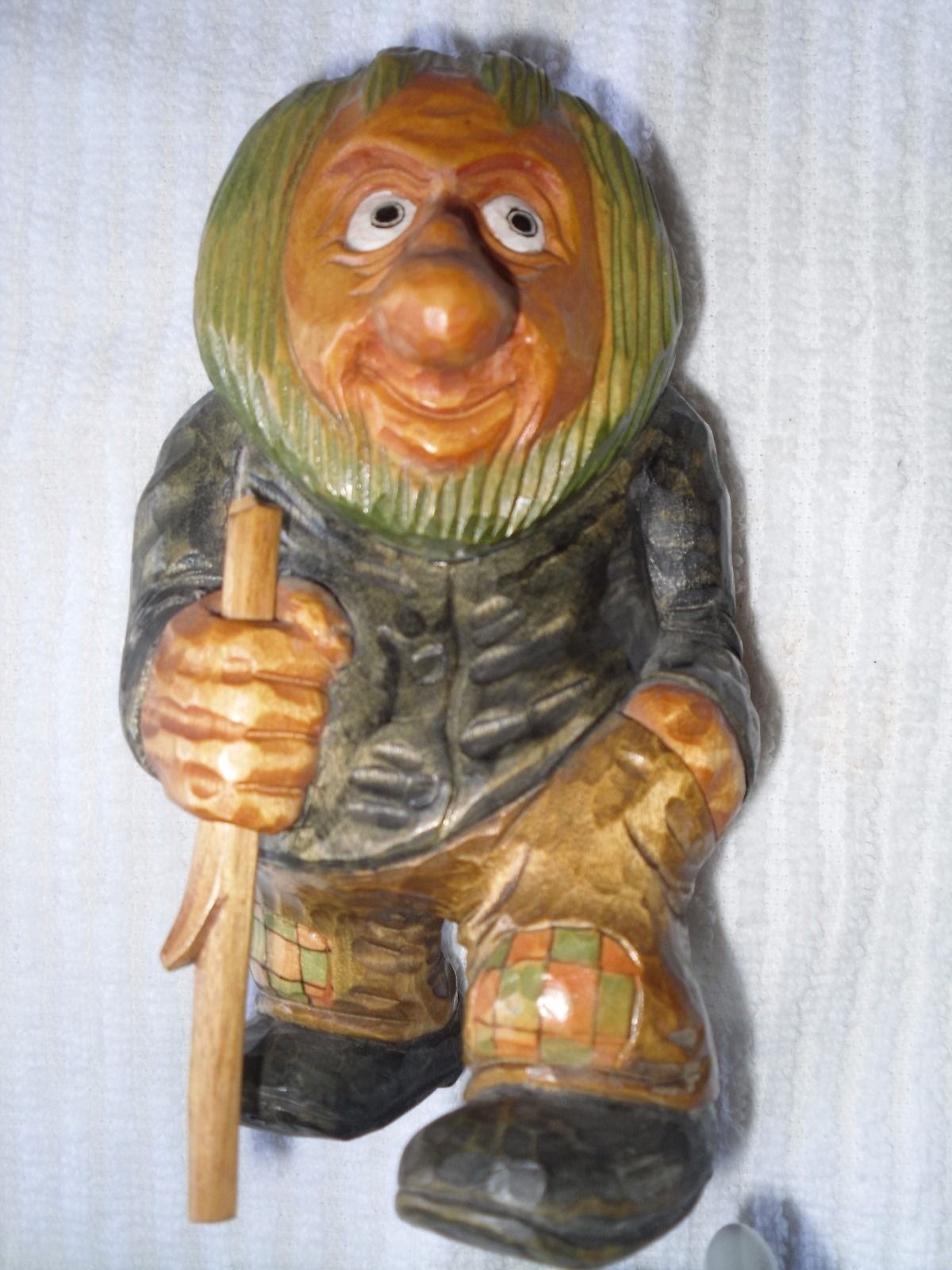

Anton devoted his life to producing unique trolls, that have since made their way around the world. And as long as they are around, and people love trolls, he will be remembered.
Today these wooden carvings are extremely collectable and highly valued by those who own and love them.
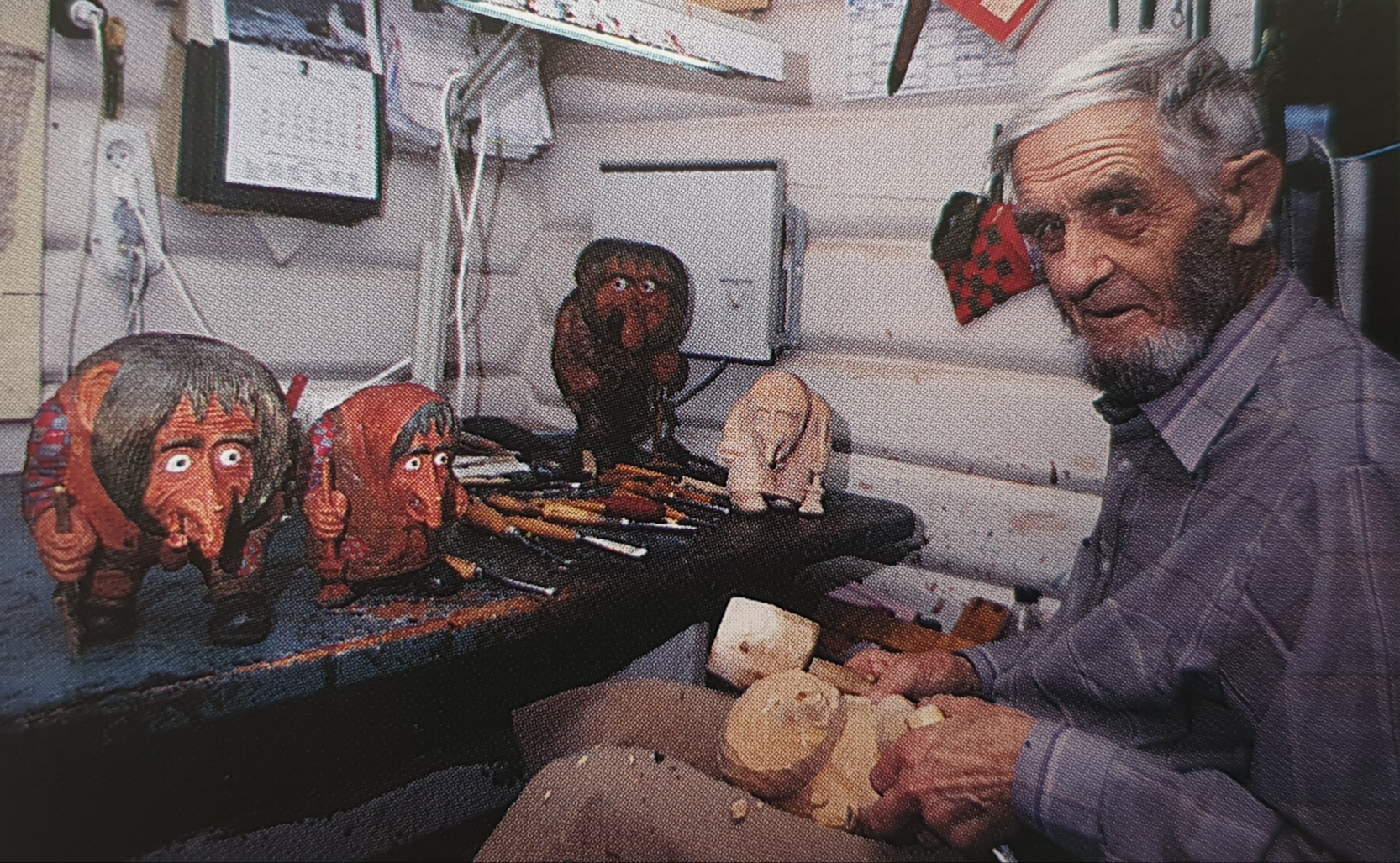
About the Author
Born in East London, South Africa, Dayne Skolmen developed a passion for writing articles in his early 20s. His favourite subjects to write about are interesting people, places, and items from the past. With every article he writes, he discovers all the details about his subjects and pieces them together to form a brief history for you to enjoy.
For more articles visit Dayne’s Discoveries Blog, like Dayne’s Discoveries Facebook Page to keep updated with new publications, join the Sveen Hand Carved Trolls Facebook group, or Contact Dayne to share any information, stories, or photographs relating to Anton/ Otto Sveen or their trolls.
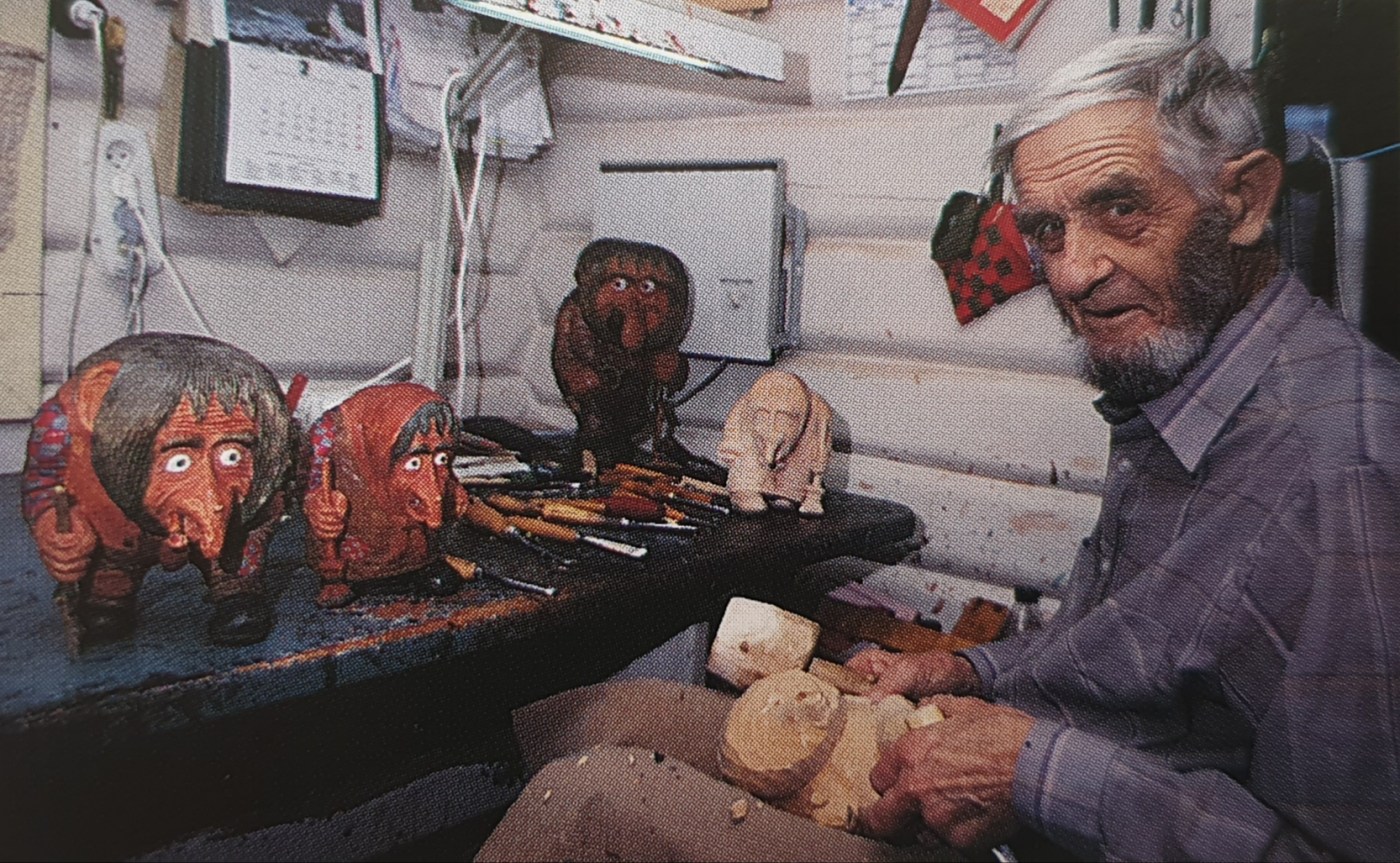












right foot is a combination of H and T. Any ideas who the carver might have been. Hardanger fjord is a wonderland, I sailed it many times, bringing limestone from Llandulas, Wales to Odda
Regards,
Cormac.
LikeLike
I treasure the figure of a hunter which I acquired in Odda around the year 1960. Signature on sole of right foot is a combination of H and T. Any ideas who the carver might have been. Hardanger fjord is a wonderland, I sailed it many times, bringing limestone from Llandulas, Wales to Odda
Regards,
Cormac.
LikeLike
I’ve got a photo of one of Anton Sween’s troll that my brother brought back from his travels. This article was invaluable in discovering the carver and providing me with examples of the colors used. (My photo is in B&W)
Thank you for the thorough article. 🙂
LikeLiked by 1 person
I’m fascinated with carved wood trolls, thank you for collecting and sharing so much about the artists behind these and the Hennings.
LikeLiked by 1 person
While working in Norway – Andalsnes on a barge assisting in building a offshore platform for the Northsea Oil and Gas production. I asked a co-worker with more time-off if he would buy me a troll. He came back with what I now know as a Anton Sveen troll. I loved the troll and it is still with me in good condition altough faded paint has set in. regards Fred Rappard. Rotterdam the Netherlands.
LikeLiked by 1 person
My great grandparents came from Gudbrandsdal. I and 4 of my sister’s visited there in August of 2019. Enjoyed your article, will share it with my sisters. Victor
LikeLiked by 1 person
I have a wooden picture with the name of H.Sveen Nybakken dated 1968. My husband is Norwegian and this picture was sent from Norway to his mother who now is in the USA. What can I do with this?
LikeLike
We just saw this blog recently. My husband’s grandfather and grandmother were from Lesja in the Gudbransdalen Valley and we still have relatives there. We have had the chance to visit a couple of times and my husband has a pair of Anton’s trolls – I think he got them in the 1980’s.
My husband’s grandparents immigrated to North Dakota in the late 1800’s, along with many others from Gudbransdalen. They homesteaded in northern North Dakota, and we still own land there. Our land is farmed by two brothers whose surname is Sveen. Probably related to Anton in some way.
LikeLiked by 1 person
As a neighbor, it was interesting to watch Anton and Jenny working.
Very nice people.
LikeLiked by 1 person
Hi Astrid. That must have been great to experience, do you own any Anton or Otto Sveen trolls? If yes, I would love to see them. If you are on Facebook, you can join the official Sveen Hand Carved Trolls group. The group consists of many collectors and family relatives, including Anton’s son Oskar Sveen who also made some trolls and is a woodcarver by career – https://www.facebook.com/groups/2690434104328118/
LikeLike
I visit Anton and Jenny on my 18 birthday in 1981. We buyed a pair of trolls in 1980 and visit him in 1981, we also make pictures in his house, the table where he make the trolls. Years later we have a lot of Trolls from Anton and only one from Otto. I like to read your story.
LikeLiked by 1 person
Hi Hanny. Thank you for your comments, that is very interesting indeed. I would love to see all the pictures you have of Anton Sveen at his house, as well as of your Sveen troll collection 😁 If you have Facebook, you are welcome to join the Facebook group “Sveen Hand Carved Trolls”. There are many other collectors in this group: https://www.facebook.com/groups/2690434104328118/
LikeLike
I was lucky enough to find one of Anton Sveen’s trolls last year this article helped me figure out who made it.
LikeLiked by 1 person
Thanks for the article it was very nice I enjoyed it..
LikeLiked by 1 person
Thanks, Vickie. I am glad you enjoyed it 🙂
LikeLike
Thank you, i’ve been looking for the information about anton sveen for a long time
LikeLiked by 1 person
My pleasure. Glad you found the information useful.
LikeLike
Enjoyed the article. First heard of Sveen a few days ago in a troll group on Facebook. Have to find one now!
LikeLiked by 1 person
Thank you for writing this Dayne! Anton was my grandfather and I really appreciate your work in piecing this history together! I’d love to talk to you more sometime if you’d be willing to exchange contact info…
LikeLiked by 1 person
Hi Jackson! It was wonderful to hear from you, I am glad you enjoyed my article about your grandfather. It was a pleasure to research your family’s history and to bring to life this wonderful story about your grandfather’s artwork. I am sure you have some great stories and information. You can contact me here: https://daynesdiscoveries.com/contact-2/
LikeLike
I enjoyed reading this. Anton was my grandfather. My mother Oddbjørg Marie is the oldest of his children. I also have some trolls from him. I remember when we was at Sveen and he always sat at the table in the kitchen and made his trolls. We were not allowed to touch his tools. They were very sharp. I have some good memories from my childhood at Sveen.
LikeLiked by 1 person
Hi Berit. I am very glad that you enjoyed my article about your grandfather. Thank you very much for sharing those wonderful stories. I would love to hear the other family stories you may have. You can contact me here: https://daynesdiscoveries.com/contact-2/
LikeLike
Great read. Thank you.
LikeLiked by 1 person
My pleasure. Glad you enjoyed it, Helene.
LikeLike
Loved the article….very interesting individual. Great talent…Thank you for sharing.
LikeLiked by 1 person
Thank you, Charmaine. Glad you enjoyed it!
LikeLike